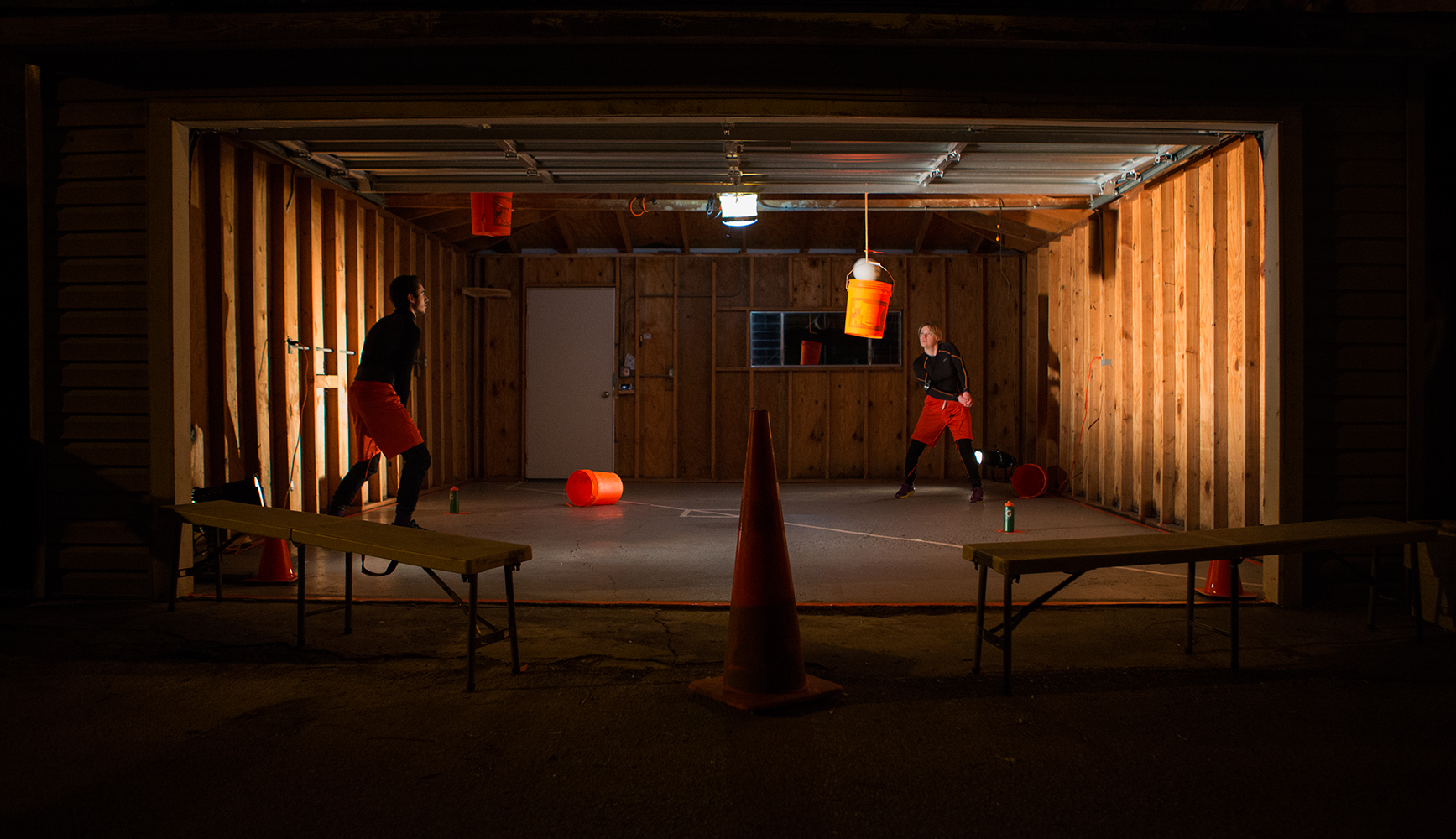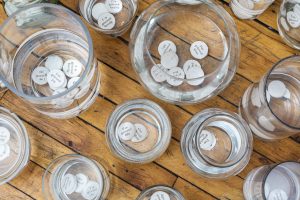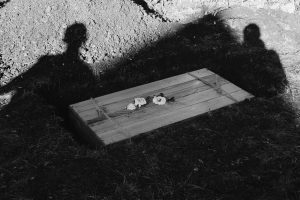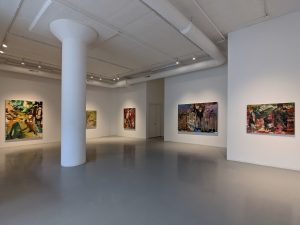“Intimate Justice” looks at the intersection of art and sex and how these actions intertwine to serve as a form of resistance, activism, and dialogue in the Chicago community. For this installment, we talked to Lauren Steinberg in the grass of Lincoln Park about a queer future, pop culture, and rolling around online.
S. Nicole Lane: We can begin with your background. You’re from New York City.
Lauren Steinberg: Yeah. I grew up in New York City. Manhattan. My dad, he’s 75, he’s an older dad. He grew up there too, and he never left. He refuses to leave. He kind of tried to instill that in me. It worked for a while, I ended up going to undergrad at Pratt in Brooklyn. I think I wanted to punish myself a little bit for being an artist. Not that I didn’t love Pratt, Pratt was amazing, but it was definitely the most rigid school that I got into at the time. I was like, “If I’m really going to do this and suffer, because everyone tells me I’m going to suffer, I might as well figure out now if it’s worth it.” They had a really intense foundation year, but I stuck it out and I did sculpture there. Sculpture ended up being taught by this really amazing guy, Curtis, who was a Yale alumni. He ended up letting us do whatever we fell into, and that’s where the more performative practice started getting folded in, toward the end of my education there, which made me really pissed, because I was like, “Wow, I finally only just started finding this medium.”
Simultaneously, for art supplies and money, I used to make these really dumb and weird abstract sculptures out of blinds, kind of looking like some garbage, fallen apart, Frank Lloyd Wright, something weird like that. I was curating and assembling what I didn’t realize was going to be folded into my practice: this drag company. I use the word “company” very loosely, because it was just me and a bunch of my other queer friends, self identifying dykes, mostly, that would go to parties, or events, or even bars sometimes, dressed up as our favorite boy banders. My specialties were Jesse McCartney and Justin Bieber. At the time it kind of worked more, he was a little bit more feminine looking, and I was a little less feminine looking and my body hadn’t really filled out yet. I was doing that and performing a lot on the side for fun and for money, but the process of it was so performative in terms of, how do you learn how to be someone else? How do you embody this line of gender, and how do you push that into a sexual way to get money, in that weird respect?
That was happening while I was making these sculptures, and then I ended up going to California to be a counselor at an arts-focused summer camp called Oxbow. Not Chicago’s Oxbow, Napa’s Oxbow. I ended up doing that for a couple years and really loving it. It’s this really small, mostly rich kid art summer camp. They live there, and you live with them in dorms. They’re like 13 years old, and they do printmaking, sculpture, they have a house for each thing. I did one of my drag shows there by myself, and I ended up getting some weird attention from some younger kids that really freaked me out. They were being sort of sexual towards me, and it really weirded me out because they hadn’t been prior to that day or night that I performed. I got really in my head in terms of: what is this performance doing? How does queer performance interact with someone who might not have identified as queer, or thought of queerness, and now is exploring that? I think that was almost a turning point in a way of it being like, “Okay, I’m going to make work about this. I’m going to explore what this relationship and desire means, and I’m going to start making performative work about that.”
That was the shift when I stopped making sculptures and started making these more performative works. They began really narrative but have become really abstract.
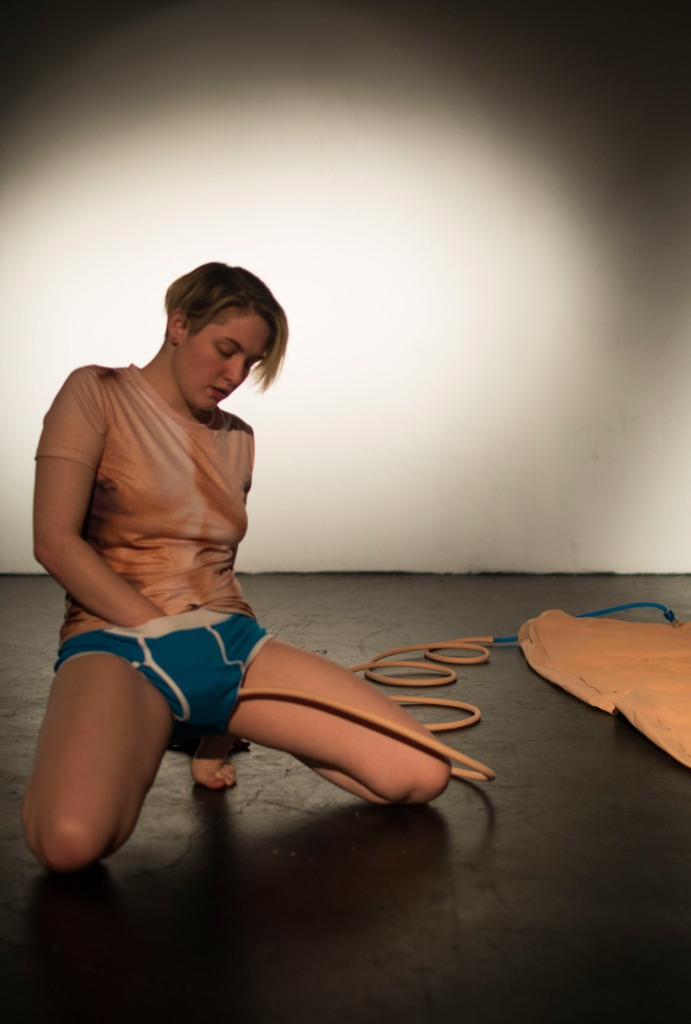
SNL: Yeah. But there are still themes of pop culture in your work, right?
LS: Yeah. It used to be strongly hinged on that. I think that was kind of my jumping board into starting to think about my own sexuality and it was really easy to do that when I had these icons, or this already established relationship between fan and celebrity to feed off of and think about. But then the more you dive into yourself, the more you see the kind of sometimes problematic behaviors. I did a lot of research in grad school about pickup culture, and pickup language and male pickup language, because the older I got, the older the people who I was imitating were, and the more and more they would display really fucked up behavior. Which I was not into, but I still felt really strongly tied to these people because I had been imitating them and doing drag. They say these really messed up things, I would be like, “This is really fucked up, I don’t agree with this” but I also had used some of their “swag” in my life to get with women or to get money to make material. So this was really problematic and I started moving away, only in representation, from these figures and more diving into myself. I think the word “imitation” comes from that. So for me, using that word is different from me saying “drag.” I think about how I used to spend hours memorizing facial expressions.
I really like humor in my work. That’s really important to me. The piece I have in the Leather Archives show, when I’ve shown it to people they laugh. It goes on and it goes on and it goes on, and then the laughter might become like, “This is really upsetting.” It’s kind of that idea of taking the joke a little bit further and further and further and trying to break it down.
SNL: Yeah, I noticed I had that same reaction watching some of your work, which I feel like I also experience with other performance artists as well sometimes. You begin by laughing and you think it’s a joke, and then it goes on. Your performances that I watched were pretty long. It’s like you go through these waves of emotions where you feel bad for the artist, and then you don’t know how to respond, and I can only imagine watching it in person. It’s probably interesting to see those reactions from people too.
LS: I know. I’ve only performed that piece once live. It’s one of those pieces where if I’m going to do it for a show, I need to know a couple months in advance, just for training purposes. For me, I like to know a little bit ahead of time so I can train up to the point where I’m not going to hurt myself, but it’s still going to be very intense for me in a different way. I’ve only performed that piece once, and it was really weird because it was in a show where they put it near the area where people are eating the snacks and the wine. It was in a queer friendly space and you can actually really see the mattresses simultaneously deflating while it’s inflating, so there’s this idea that it’s not working, but it is. When you look at the video over a seven minute time and it’s sped up, you can see that it’s inflating. But when it’s live, people think I fucked up, or it’s part of it, it’s never going to inflate. I really like this about time as well. If you leave for an hour and you come back, it’s like, “Oh my god.” That’s something that I find really interesting with that piece. If you’re there with me the entire time, you’re in panic, but if you leave, if you make that choice to leave and then come back, there’s kind of a relief of “Okay, maybe it is working.”
I think the word “queer”—and I embrace that word so much—is the crux of a lot of my work. Which is so interesting because at the same time I had Italian curators talk to me and they read my artist statement and they had no idea what that word even meant. It’s this funny thing where I don’t know exactly what the word is but that’s the closest thing that I can really put on the work. At that time, I was dealing with a break up. I was dealing with dating a queer woman who was very fluid in their sexuality and had just recently left me for a straight white cis dude. As much as I was supportive and understanding of queer fluidity, I was pissed. I was feeling really insecure. I was looking at my body all the time and being like, “This body, four or five years ago, was super androgynous.” I could pass through these drag situations really easily. Now I have to bind, and I’ve become more shapely. It’s about embracing what that means in your identity. That piece was about taking what you have and pushing it and pushing it and really getting to that point.
At the end, I get to rest, and it’s like, “You did it.” For me at least, as a performer. I’ve had people say they have different kinds of interpretations, but as a performer, at the end, I never fully inflate it. I just get it enough to when I know that I can rest. That’s really important to me, because then the air becomes a material in itself. The action of inflating is one thing but the air inside the mattress is almost a marker of time. That’s something that I play around with in newer work as well: Using air as a material inside things.
SNL: Can you maybe talk about the themes of inflation and air?
https://vimeo.com/165064646
LS: The last year of grad school I was using a lot of inflatables as props. It’s almost like the relationship between me and that one inflatable is like the relationship between me and that object, and that would be the stage to set for the performance. I have another piece with an inflatable crutch, which is a small piece that I think is a little bit more political. As I’m sure you’ll probably talk to a lot of people, the election changed or shifted a lot of things for a lot of artists artists in a way. You know, I make work about queerness, and sexuality, and the body, but I have often stayed away from internal reflection on how that puzzle piece would fit in a broad American sense. That’s something that I’m shifting a little bit more towards now. In terms of the vocabulary of inflating, Besides the obvious clowny references of, you know, a dick inflates or deflates or sexuality can inflate or deflate, and climax and stuff like that. I really do think that focusing on this material of air as time has been something that has really stuck out to me. I think a lot about time because I think a lot about Futurity in the work. I’ve read a lot of stuff about queer Futurity, like: what if we embrace the idea that as gay and lesbian and queer individuals, we are not reproducing? We’re not doing this for reproduction, we’re not doing this all for the future of everyone else, and the world is so focused on the child, and the future. What if we’re like, “Yeah we are the fucked up sinners who don’t want things to go forward.” Which is such a pessimistic view and I’m not saying that I agree with it at all, but I’m saying that I am interested in time and the future as something to think about, and something to maybe change or re-look at.
I like to use inflating and air as these redefined symbols of time and looking towards that future. When you see a deflated object, you automatically begin thinking about what it might look like inflated, or how is it going to get inflated, or where does this tube go?
https://vimeo.com/204988530
SNL: Do you always perform in front of an audience?
LS: No. I used to do a lot of performance for video, and I’m working on a piece right now that’s going to be a quieter, longer piece that is more of a film, I would say, with performative interruptions inside of it. I’m performing for a camera in outdoor spaces where no one else is really there. That’s something that I’m exploring now, I’m thinking about how I’ve made a lot of work in the white box, and I’ve made some site-specific work that’s been great.
There was a piece that I did called Passrite that ended up as a big display that was in a garage, but the process of preparing for it and the research and everything was all outside on soccer fields. The newer work is all outside.
I did a road trip to where my family is from and I did some performative stuff there. I was re-placing my body in these places where I have memories that are also really charged in terms of like, I don’t really talk to that family anymore, because of how different they are from me. Part of the piece is actually rebuilding those bridges with that family. I’m not really sure if that would be shown, or how it would be shown, but it’s more for me to start reconnecting with communicating with people that maybe need to be communicated with in order to not demonize someone who’s like me. That’s so cliché, in the way that everybody’s like, “We need to talk to each other!”
After the election I was really curious what it be like to reach out to these family members that I grew up with. We all stopped talking when I was sixteen. They were the first people I came out to, it’s very emotional. They’re not like the people who are painted in the media, they’re normal real people. They’re real people doing their real things, and they have very different views but they’re still emotionally really attached to each other. It’s this weird tension with that, so I’ve been working on that.
I’m feeling a little disheartened by art, as we all are, there’s ebbs and flows. The gallery, and the residency, and the grant, and just looking at all these things on my computer like, “Fuck this, this isn’t going to do anything!” I’m at that point where I identify as a performance artist and I so love that, but I also see a lot of performance work and I feel so disconnected from it. Sometimes I see some performance work and I think there should be two names for what is happening. We’re dealing with such a different way of using the body. There’s this lineage of performance art versus combining it with other things and continuously breaking the walls of it until it’s never going to be identifiable. Because that’s the whole point, in a way, you’re kind of allowed to do anything and expound those boundaries, which is why I love making performance work. Still, sometimes, I am just so weirded out by what galleries—what calls want in a performance work. Sometimes I feel that I need to take a break and take a step back and reevaluate.
SNL: I totally agree. I feel like I’m on the downside when I think about art right now. I don’t know if it has to do with anything in particular in what I’m seeing in Chicago or what, but I definitely understand where you’re coming from, and I think sometimes it’s best to not even look at what other artists are doing, and I’ve had to take a step back from that.
LS: I really only just got capitalism. Like really dived into it and just learned it this last semester, because I had a really amazing teacher that just exploded my brain. I finally understand that at the same time that this election has been happening has been a really hard hill to climb over in terms of being like, “What is the point?” I know so many beautiful artists who have never gotten a pedestal or a place to shine, who are queer POC, trans, people that identify in communities that really need to be out there and really need to be saturating everything. Sometimes I just want to take a step back and help support that happening more so than continuing with my voice. I think my voice is still important. Sometimes I get really emotional when I see queer calls, and I want that to be out there as much as possible. People like me have been around forever— white and lesbian. I struggle and I go back and forth between being really confident about that and wanting to be behind the scenes a little bit more and really supporting others who I think are really important. That’s something that I’ve been dealing a lot with lately too.
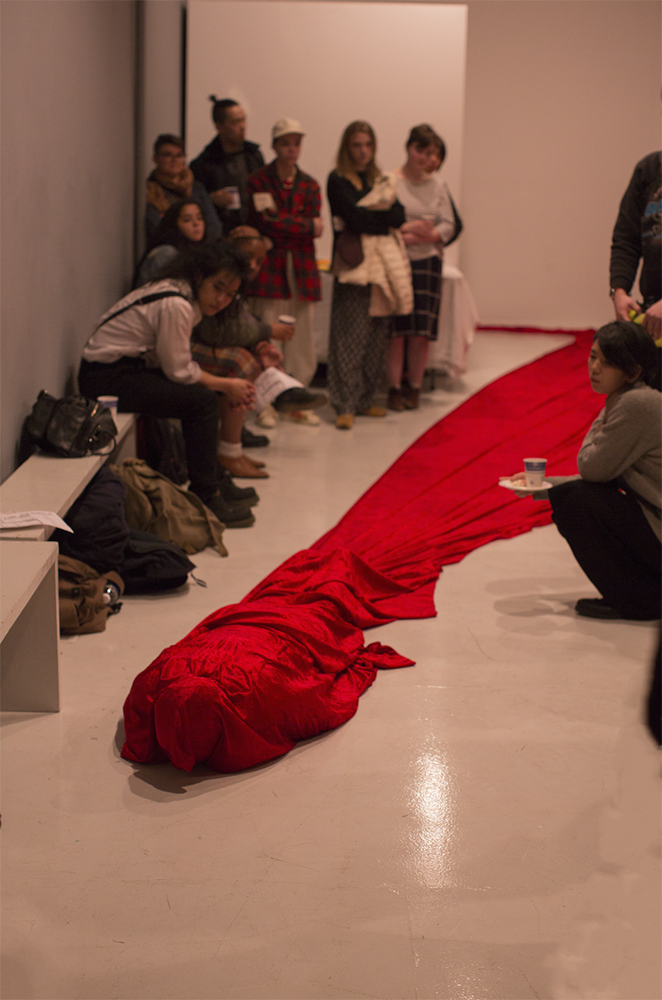
SNL: Yeah. I totally understand that. I think that since writing is what makes me money, and then making art is just what I do for myself, in the past year, I’ve kind of shifted and been like “Okay, my art is whatever right now. All these other people are doing all these great things, so I’m just going to contact them and try and get their work out there.”
And I think that’s important.
LS: It’s important! All the cogs are important. I have a really weird knack for administrative stuff, which is so funny, and I did that all during grad school. Because I’m an artist and I know what needs to be done to make it great, but then because I’m also very organized, I can sort of be brash and blunt with a lot of things. That’s my New Yorker side. I can get shit done, so I have a lot of people being like, you know, you should dive into some administrative stuff on the gallery/museum side and try to get in there and meet people and eventually work your way so that you have contacts in those areas. Of course I’m never going to stop making work and of course I show and it’s once in awhile, but yeah like you were saying, it’s kind of that “finding yourself” moment.
Things aren’t funny—it’s not as funny as it was a couple months ago. I look at some of the work that I made and I’m like, “Yeah it makes sense, it’s great, like whatever, but it’s so different now, which is sad for that to happen because it’s not really that different, but the reality is that people who are seeing the work who maybe aren’t artists or aren’t in our bubble, like my family or like my partner who’s an architect and her friends, they’re going to see in a different [context] than it was a couple months ago. It’s a really trying to re-find where your place is, and where art’s place is, in everything. I think sexuality has a lot to do with that, because if we keep challenging the status quo in terms of what is acceptable. I watch the news and I don’t know why it feels like I’m living forty years ago. It’s weird. It’s not even just the political stuff, even though I’m a huge political junkie.
Even when I was home and visiting my parents, they like to watch The Today Show in the morning to get ready, and that’s their routine. Even the smallest like, “Hey, it’s a beer for women!” kind of thing, where I’m like, “What?! Why?” My voice needs to be heard, every single queer voice in the world needs to be heard, because this stuff is such bullshit. It’s so unbelievably regressive in so many ways. I’m really glad that I went to art school, in a lot of ways. People are like, “Oh, now you’ll never get a job,” right, that whole rhetoric. Even if I never got a job, and I’m destitute and poor, I can meet someone at a party and I can and have, multiple times, changed their mind or at least exposed them to a way of thinking that they literally would never have tapped into. That’s astonishing, when you finally realize that being an artist, or being in school, has given you that kind of power, to really—it’s not arguing, because it’s not like I hate on those people and it’s not like I’m trying to shame them into a different way of thinking, it’s literally they’re like, “So what is trans? What is queer?” They just don’t know, and it’s unreal because it’s so part of our lives, like every day, and that vocabulary is so steeped in what I do, and I’m sure you’ve experienced the same thing. It’s unreal, the lexicon, the language hasn’t even been written for some people. They haven’t even tapped into that side of their brain that is there! And they’re sweet people.
SNL: Right, I know! And it’s hard to be mad at them, because they just haven’t been exposed to it, or have just been ignoring it.
LS: Right! It’s just crazy to think about that. It’s not like these people are bible-thumping, wanting me to go to hell. These are just normal people. It’s that line between assimilation and staunch rejection. Assimilating, wanting to be “normal,” you know? Like I’m a monogamous person, and that’s definitely not like the queer agenda in a lot of ways. I’ve taken my fair share of little jokes about that. I date people who don’t have that vocabulary as much. People that I seem to tend to date have been steeped in a totally different world, and that’s why I think I love them, because I’m so interested in that perspective and I think that it’s really important to have multiple queer perspectives. Literally anyone who complains about like being gay or being a lesbian and white right now, I’m like, “Why are you even complaining, that’s not the fight that you’re fighting for.” When you fight for queerness, when you make work about queerness: yes, we’re still different in a lot of ways, but you’re trying to get people interested that see you as safe, almost, as a safe bridge to deeper rooted issues. So when people come up to me and they can ask me “What’s trans,” it’s because I’m a white kid who was nice to them at a bar, you know? They can identify with me in that way, and so maybe I’m not representing somebody who really needs to be heard, but through those conversations I can lead someone closer and closer to those understandings of people that are really fucking struggling and it’s really fucking terrible.
I think about that a lot in terms of the work, because if the work really isn’t the voice that I think needs to be out there, then maybe it’s a stepping stone for someone who maybe doesn’t know how to access or feels intimidated by performance work that has to deal with a lot darker issues.
I always have my friends who are like, “What’s going on with you, what do you do? I see you rolling around online.” I’m not an actor. The history of the practice that I do is not rooted in literature. It’s rooted in the rejection of painting. I think sometimes people make really negative comments and stereotypes about performance work and it’s so fucked up because they’re so closed off to it and they didn’t get there in a good way, so they’re just like, “Oh, you’re throwing food and eating off of each other and fucking each other and getting tattoos.”
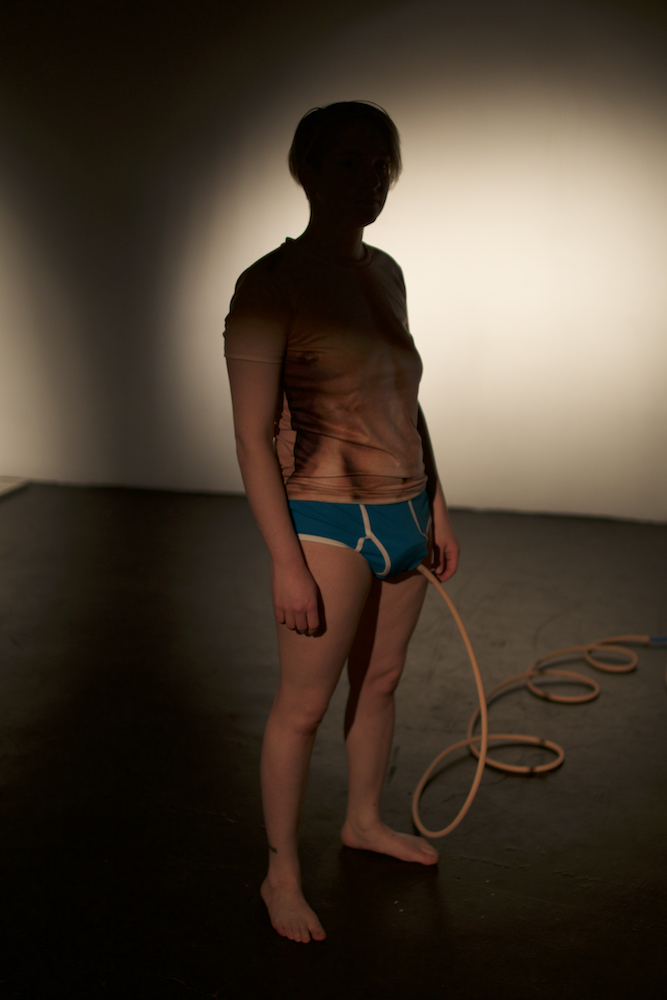
SNL: Right, so introducing them to something that is somewhat similar can help ease them into the broader view of performance.
LS: Yeah. The other side of that is there are radical people that I am friends with and agree with and a hundred percent support that are like, “Fuck all those people. It’s my body, my work, and it’s not about them.” And I’m like, that’s totally legitimate, and you’re angry because you have a right to be angry, we all do.
SNL: Do you see your work as resistance?
LS: I don’t label my work as social practice work because it’s not. My protesting and my volunteering and all of that is more personal. It’s not as tied to my work in that direct linear way, even though everything is tied. I think it’s quieter, the work is more rooted in these staged events, stage props, stage lighting, things that you walk into a space and it can completely transform it.
What do we subscribe to different objects? Materiality is really important for sculpture. I guess it’s kind of about uncovering layers and really just trying to get into someone’s head and how they are approaching objects or even performances and what their expectations are. For me, my hope is then to say, “Okay then what is expectation? Why are you bringing expectations?”
I think I’m more of an inchworm, and I guess maybe the two hours of fucking the floor is a good metaphor for that. I like to crawl, I don’t really run. I’m not a sprinter. I think it’s slow radicalism in that sense, maybe just trying to exercise the brain into reevaluating or rethinking, and sometimes it can seem really brash and in your face. We are literally in the middle of a hurricane. Everybody says it should be so exciting but I think it’s crippling.
SNL: Yeah! I agree. I’m having a hard time.
LS: It is exciting, I guess. It’s really hard to push through a lot of the thoughts and to not succumb to the feeling that none of this matters, because it would be such a deafening blow that it’s hard to recover.
What do I do to help myself? Every day you’re making work. You and me talking is making work, subconsciously it’s seeping into our brains, which is something I’ve really had to learn. I actually learned that from a writer, because of writer’s block. I was asking her about writer’s block and she told me there’s no such thing, really. She said it’s about getting over the fact that when you’re doing laundry, you’re writing. When you’re making breakfast, you’re writing. It’s getting over that anxiety that you’re never getting rid of it, it’s always there. Once you can completely be zen about that, that’s like nirvana. Obviously none of us can really get there, it’s really hard, but I just really thought that was beautiful. Especially if you’re making work about performing! We’re all performing all the time in everything, gender performance, political performance, all of it! It’s all one big clown show. America is so complicated and interesting because it’s not a dictatorship or a country where performance is at its ultimate high in a very different way. It’s this melting pot where different people are performing in different percentages all the time, and it’s really hard. The question of what is authentic really drives me crazy because I make work about pop culture, you know, nothing’s authentic. There’s no such thing as authentic feeling!
SNL: Maybe this isn’t a good question, but—
LS: What’s up in the future?
https://vimeo.com/194916775
SNL: Yeah! That’s always the closing statement.
LS: I have some quieter pieces that are going to be a little bit more research based, longer in terms of execution, and in the environment more. I’m even working with a friend on a podcast, which is what everyone is doing now.
I think that for me right now, I have a desire to do something a little bit more narrative and storytelling based, because a lot of the work I’ve been making has been very abstract, and very for the bubble. By the bubble, for the bubble. I’m very excited to be out of the bubble in that respect, to be exploring other artistic communities that might be able to touch someone who’s not so well-versed. I think being a performer and a performance major, you’re automatically closing off a large audience, which is good in a lot of ways. I don’t make sellable work. I think it’s going to be fun and interesting to bring that perspective into other networks that have audiences that are a little bit more familiar with other things.
Queerness is this thing that’s catching fire in a lot of ways. I’m really focused on trying to get involved in volunteering. I’m also trying to figure out in terms of like,when I have money, how I can get more active in terms of political stuff, but also queer youth volunteer work. That’s something that I felt like I could not do in school as much because it was just so intense that I had to be really, really, really fucking selfish.
Yeah, that would be a closing remark. It’s kind of nice to not have to be so selfish for a little bit. I feel like in grad school I had to turn it on. I think in all areas of my life it’s going to be really nice to be not selfish. Not the selfish artist, not an egotistical artist, and to be someone who is helping other people. Whether that’s helping my partner get her architecture license by cooking her dinner every night because I can now, and helping her clean her apartment, or going out there and helping other artists get into gallery shows. That’s something I’m really looking forward to going out and be able to do more freely now that the institution isn’t on my back. But then hopefully keeping that drive in a very different, quiet way. Then maybe popping out some really crazy awesome stuff in a couple months that I’ll be really proud of and that it’ll be really nice to have. I’m not sure how that’s going to end up looking, but I think that’s the point right now. I’m collecting things, I think a lot of artists like to collect stuff, so it’s definitely at that collection phase.
MaterialKink is at the Leather Archives & Museum until January 14, 2018.
Featured image: Two individuals are in two separate corners of a room with red shorts on and black tops. In the center, between them, is a orange Home Depot bucket and a volley ball.
Photo by Farah Alhaidar
 S. Nicole Lane is a visual artist and writer based in the South Side. Her work can be found on Playboy, HelloFlo, Rewire, SELF, and other corners of the internet, where she discusses sexual health, wellness, and the arts. Follow her on Twitter.
S. Nicole Lane is a visual artist and writer based in the South Side. Her work can be found on Playboy, HelloFlo, Rewire, SELF, and other corners of the internet, where she discusses sexual health, wellness, and the arts. Follow her on Twitter.
